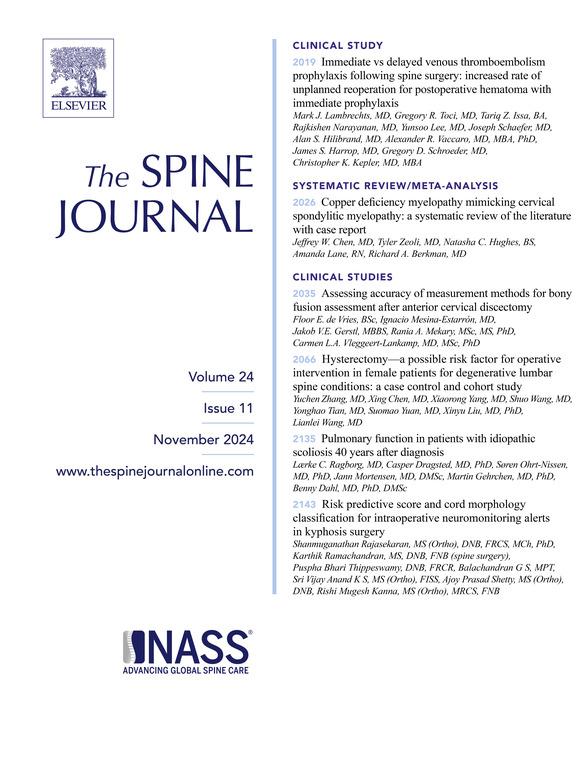12. 脊髓间质肿瘤患者术后立即神经系统改变的预测因素
IF 4.7
1区 医学
Q1 CLINICAL NEUROLOGY
引用次数: 0
摘要
背景:髓内脊髓肿瘤(IMSCTs)是一种罕见的中枢神经系统肿瘤,生长在脑膜下,可侵犯脊髓实质。疾病进展与高神经功能损害风险相关,这必须与目前的护理标准——总全切除(GTR)治疗的发病率风险进行权衡。鉴于这些肿瘤的罕见性,术后立即神经系统改变的数据在范围和普遍性上是有限的。目的:我们评估几个围手术期因素对imsct患者术后即时神经系统预后的预测价值。识别神经功能缺损和改善的重要预测因素可以在共享决策模型中改进手术前风险评估,以确定治疗方案和患者咨询。此外,加强对预测结果关联的理解可以帮助优化护理标准。研究设计/设置在这项单中心回顾性队列研究中,我们整理了一个数据库,其中包括2002年12月至2020年1月在匹兹堡大学医学中心医院接受imsct手术切除的所有患者。患者样本:数据库中的138例患者中,90例符合本研究的纳入标准,基于完整的术前和术后即时神经系统检查信息的可用性。其中,70例(78%)接受了近总切除(nGTRs,术后mri目视检查≥90%肿瘤肿块),20例(22%)接受了次全切除(STRs)。患者涵盖5种肿瘤病理类型:星形细胞瘤(n= 3,3 %)、室管膜瘤(n=33, 37%)、黏液乳头状室管膜瘤(n=24, 27%)、血管母细胞瘤(n=18, 20%)和低级别胶质瘤(n=12, 13%)。主要结果是术后立即神经系统的改变,以术前和术后立即检查的差异来衡量。结果被分类为“无差异”、“缺陷”(从术前到术后的负面变化)或“改善”(从术前到术后的积极变化)。方法采用R语言进行fisher精确检验,探讨主要转归与6个相关变量之间的关系:切除程度、肿瘤病理、肿瘤位置、肿瘤复发、既往手术和术中躯体感觉诱发电位的关键变化。通过事后两两比较和Bonferroni校正来评估水平特异性关联。显著性定义为p <; 0.05。结果术后即刻神经功能改变与EoR (p = 0.004)和肿瘤病理(p = 0.003)差异有显著性意义。根据事后比较,与str相比,ngtr与更高比例的术后缺陷显著相关。黏液乳头状室管膜瘤患者术后缺损的比例低于低级别胶质瘤患者。其他关联无统计学意义。结论EoR和肿瘤病理是IMSCT患者术后神经系统预后的重要预测指标。EoR与神经功能缺损之间的显著关联强调了最大限度切除肿瘤与最大限度保留神经功能之间的平衡的复杂性。同时,肿瘤病理导致的神经功能缺损的不同比例支持了对IMSCT治疗个体化方法的需求。FDA器械/药物状态本摘要不讨论或包括任何适用的器械或药物。本文章由计算机程序翻译,如有差异,请以英文原文为准。
12. Predictors of immediate postoperative neurologic changes in intermedullary spinal cord tumor patients
BACKGROUND CONTEXT
Intramedullary spinal cord tumors (IMSCTs) are rare central nervous system neoplasms that grow beneath the meninges and may invade the spinal cord parenchyma. Disease progression is associated with high neurologic impairment risks, which must be weighed against the morbidity risks of treatment by gross total resection (GTR), the current standard of care. Given the rarity of these tumors, data on immediate postresection neurologic changes are limited in scope and generalizability.
PURPOSE
We evaluated the predictive value of several perioperative factors on immediate postoperative neurologic outcomes in patients with IMSCTs. Identifying significant predictors of neurologic deficits and improvements can refine pre-surgical risk estimation for treatment determination and patient counseling in a shared decision-making model. Furthermore, a bolstered understanding of predictor-outcome associations can help optimize the standard of care.
STUDY DESIGN/SETTING
For this single-center retrospective cohort study, we collated a database comprising all patients who received surgical resection for IMSCTs at a University of Pittsburgh Medical Center hospital between December 2002 and January 2020.
PATIENT SAMPLE
Of the 138 patients in the database, 90 met inclusion criteria for this study based on the availability of complete immediate pre- and postoperative neurologic exam information. Of these, 70 (78%) received near gross total resections (nGTRs, ≥90% of tumor mass on visual inspection of postoperative MRIs), while 20 (22%) received subtotal resections (STRs). The patients spanned 5 tumor pathology categories: astrocytomas (n=3, 3%), ependymomas (n=33, 37%), myxopapillary ependymomas (n=24, 27%), hemangioblastomas (n=18, 20%), and low-grade gliomas (n=12, 13%).
OUTCOME MEASURES
The primary outcome was immediate postoperative neurologic changes, measured as differences between preoperative and immediate postoperative exams. Findings were categorized as “no difference,” “deficits” (negative changes from pre- to post-operative), or “improvements” (positive changes from pre- to postoperative).
METHODS
Fisher’s exact tests were conducted in R to explore associations between the primary outcome and 6 variables of interest: extent of resection (EoR), tumor pathology, tumor location, tumor recurrence, prior surgery, and critical changes on intraoperative somatosensory evoked potentials. Level-specific associations were assessed by post-hoc pairwise comparisons with Bonferroni corrections. Significance was defined as p < 0.05.
RESULTS
Immediate postoperative neurologic changes varied significantly by EoR (p = 0.004) and tumor pathology (p = 0.003). Per post-hoc comparisons, nGTRs were significantly associated with a higher proportion of postoperative deficits compared to STRs. Patients with myxopapillary ependymomas had a lower proportion of postoperative deficits compared to those with low-grade gliomas. No other associations were statistically significant.
CONCLUSIONS
Our findings indicate that EoR and tumor pathology are important predictors of immediate postoperative neurologic outcomes for IMSCT patients. The significant association between EoR and neurologic deficits underscores the complexity of balancing maximal tumor removal with maximal neurologic function preservation. Meanwhile, the differential proportions of neurologic deficits by tumor pathology bolster the need for individualized approaches to IMSCT treatment.
FDA Device/Drug Status
This abstract does not discuss or include any applicable devices or drugs.
求助全文
通过发布文献求助,成功后即可免费获取论文全文。
去求助
来源期刊

Spine Journal
医学-临床神经学
CiteScore
8.20
自引率
6.70%
发文量
680
审稿时长
13.1 weeks
期刊介绍:
The Spine Journal, the official journal of the North American Spine Society, is an international and multidisciplinary journal that publishes original, peer-reviewed articles on research and treatment related to the spine and spine care, including basic science and clinical investigations. It is a condition of publication that manuscripts submitted to The Spine Journal have not been published, and will not be simultaneously submitted or published elsewhere. The Spine Journal also publishes major reviews of specific topics by acknowledged authorities, technical notes, teaching editorials, and other special features, Letters to the Editor-in-Chief are encouraged.
 求助内容:
求助内容: 应助结果提醒方式:
应助结果提醒方式:


